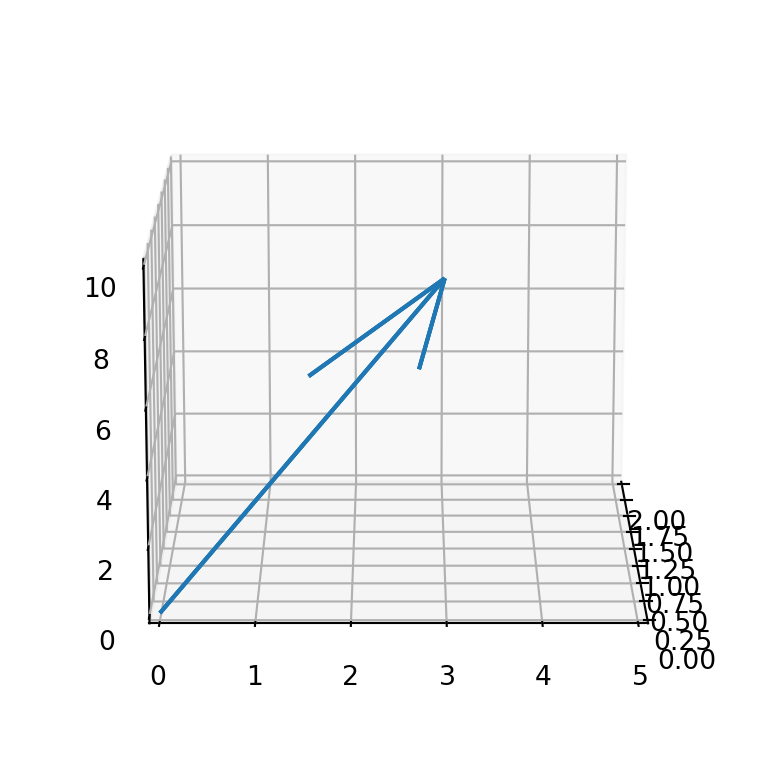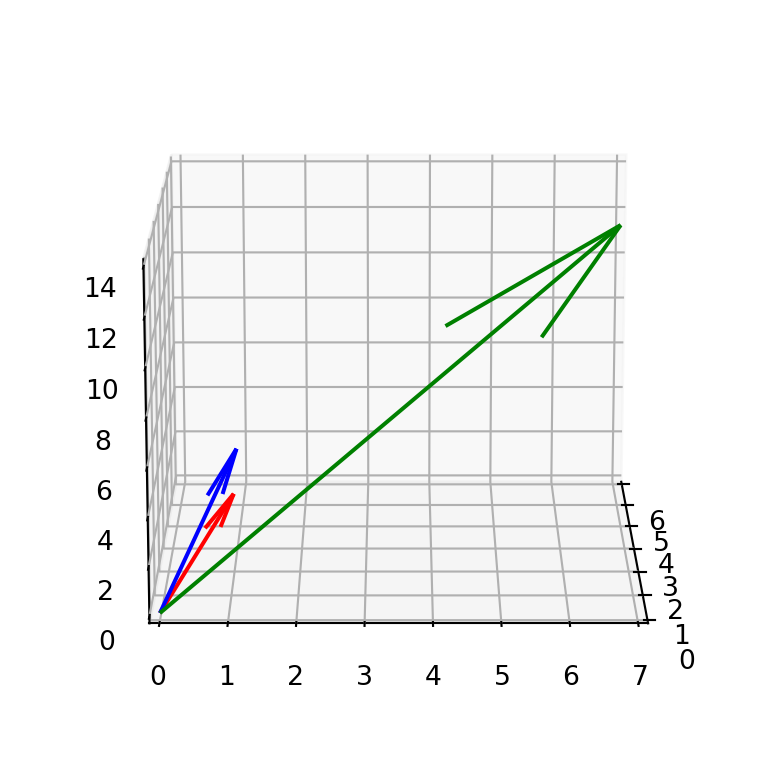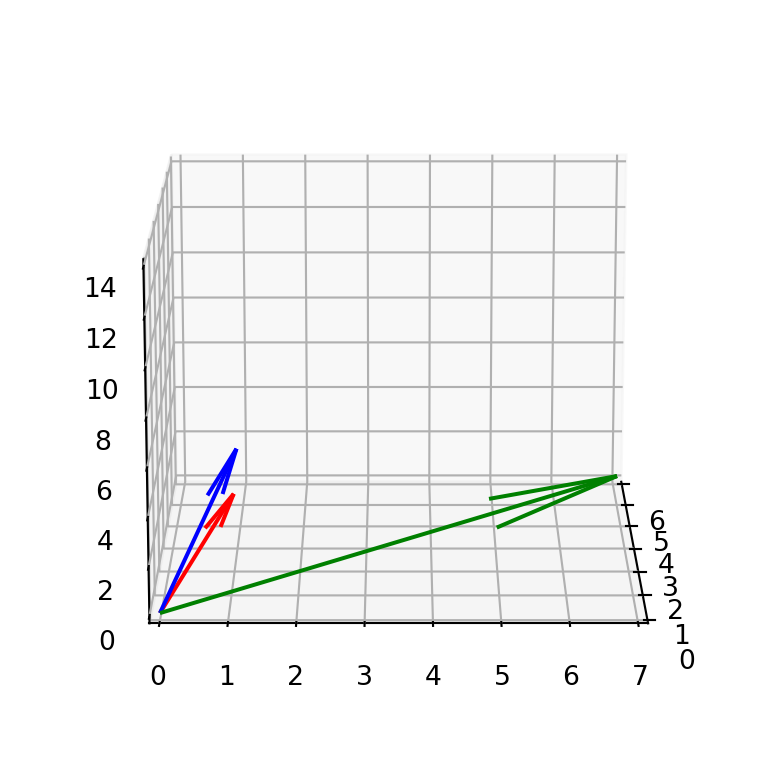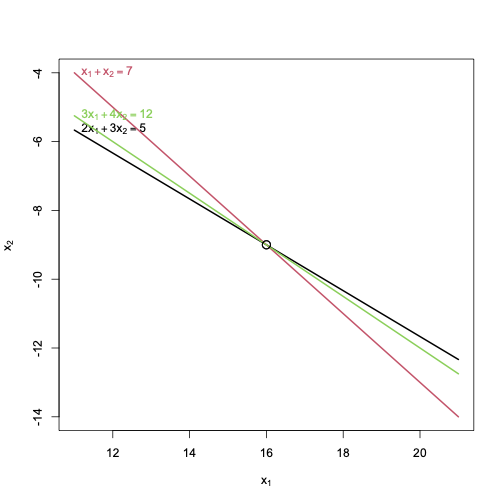Álgebra Linear Computacional
Aula 02: Multiplicando e Fatorando Matrizes
Créditos
Os slides desse curso são fortemente baseados no curso do Fabrício Murai e do Erickson Nascimento
Objetivos de Aprendizagem
Conhecer três formas de operar multiplicação de matrizes
Saber definir e identificar vetores linearmente dependentes
Saber definir e calcular o posto de uma matriz, tanto pelo posto de linha quanto de coluna
Entender a relação entre posto de \(A\) , posto de \(B\) e posto de \(AB\)
Saber realizar a decomposição CR manualmente para matrizes triviais
Conhecer a notação tipicamente utilizada para repesentar matrizes com estruturas específicas
Conceito: Espaço Coluna
Duas formas de ver \(Ax\)
Produto interno
Combinação linear das colunas de \(A\)
E se multiplicarmos \(A\) por todos os vetores \(x\) ?
o que é o espaço formado por todos os \(Ax\) ?
Resposta: Espaço coluna \(C(A)\)
Conceito: colunas linearmente independentes
\[ A = \begin{bmatrix}2 & 1 &3 \\ 3 & 1 & 4 \\ 5 & 7 & 12\end{bmatrix}\]
As duas 1\(^\text{as}\) colunas formam uma base para o espaço coluna (por quê?)
\[ C(A) = \text{Span} \{[2,3,5]^\top, [1,1,7]^\top\}\]
Conceito: Posto de uma matriz
Número de colunas (linhas) linearmente independentes
Posto de uma matriz \(m\times n\) é no máximo \(\min(m,n)\)
Posto de \(A\times B\) é no máximo \(\min(\text{posto}(A), \text{posto}(B))\)
Exemplo 1 (posto)
\[ A = \begin{bmatrix}2 & 1 &3 \\ 3 & 1 & 4 \\ 5 & 7 & 12\end{bmatrix}\]
\[ x_1\begin{bmatrix}2\\1\\3\end{bmatrix} + x_2\begin{bmatrix}3\\1\\4\end{bmatrix} = \begin{bmatrix}5\\7\\12\end{bmatrix}\]
\[\begin{cases}2x_1 + 3 x_2 = 5\\ x_1 + x_2 = 7 \\ 3 x_1 + 4 x_2 = 12\end{cases}\]
Code
import numpy as np= np.array([[2 ,1 ,3 ],[3 ,1 ,4 ]])= np.array([[5 ],[7 ],[12 ]])
Exemplo 2 (posto)
\[ A = \begin{bmatrix}2 & 1 &3 \\ 3 & 1 & 4 \\ 5 & 7 & 17 \\ 2& 7 & 11\end{bmatrix}\]
\[ x_1\begin{bmatrix}2\\1\\3\end{bmatrix} + x_2\begin{bmatrix}3\\1\\4\end{bmatrix} + x_3 \begin{bmatrix}5\\7\\17\end{bmatrix} = \begin{bmatrix}2\\7\\11\end{bmatrix}\]
\[\begin{cases}2x_1 + 3 x_2 + 5x_3 = 2\\ x_1 + x_2 + 7x_3 = 7 \\ 3 x_1 + 4 x_2 + 17 x_3= 11 \end{cases}\]
Code
import numpy as np= np.array([[2 ,1 ,3 ],[3 ,1 ,4 ],[5 ,7 ,17 ]])= np.array([[2 ],[7 ],[11 ]])
array([[12.6],
[-8.4],
[ 0.4]])
Exemplo 3 (posto)
\[ A = \begin{bmatrix}2 & 3 &5 \\ 7 & 11 & 13 \\ 17 & 19 & 23 \\ 29& 31 & 37\end{bmatrix}\]
\[ x_1\begin{bmatrix}2\\3\\5\end{bmatrix} + x_2\begin{bmatrix}7\\11\\13\end{bmatrix} + x_3 \begin{bmatrix}17\\19\\23\end{bmatrix} = \begin{bmatrix}29\\31\\37\end{bmatrix}\]
\[\begin{cases}2x_1 + 7 x_2 + 17x_3 = 29\\ 3x_1 + 11x_2 + 19x_3 = 31 \\ 5 x_1 + 13 x_2 + 23 x_3= 37 \end{cases}\]
Code
import numpy as np= np.array([[2 ,7 ,17 ],[3 ,11 ,19 ],[5 ,13 ,23 ]])= np.array([[29 ],[31 ],[37 ]])
array([[-0.46153846],
[-0.33333333],
[ 1.8974359 ]])
Teorema do Posto: Seja \(M\) em \(M_{m\times n}(\mathbb R)\) e \(p\) (o posto de \(M\) ) o número máximo de linhas LI de \(M\) , então, o número máximo de colunas LI de \(M\) é \(p\) .
Multiplicação de matrizes
\(A_{m\times n}B_{n\times p}\) como concatenação:
dos vetores \(A\, b_{*j}\) ou vetores \(a_{i*}\, B\)
\[ AB = \begin{bmatrix} | & | & & | \\ Ab_{*1} & Ab_{*2} & \ldots & Ab_{*p}\\ | & | & & | \ \end{bmatrix} = \begin{bmatrix} - & a_{1*}B & - \\ - & a_{2*}B & - \\ - & a_{m*}B & - \end{bmatrix}\]
Quantas multiplicações são realizadas em \(AB\) ?
Resposta: \(mnp\)
Multiplicação de matrizes
\[ A = \begin{bmatrix} 1 & 3 & 8\\ 1 & 3 & 8\\ 1 & 3 & 8\end{bmatrix} = BC\]
Produto externo
\[ u \oplus v = uv^\top = \begin{bmatrix}u_1\\u_2\\u_3\\u_4\end{bmatrix}\begin{bmatrix}v_1 & v_2 & v_3\end{bmatrix}\] \[ u \oplus v = \begin{bmatrix} u_1v_1 & u_1v_2 & u_1v_3 \\ u_2v_1 & u_2v_2 & u_2v_3 \\ u_3v_1 & u_3v_2 & u_3v_3 \\ u_4v_1 & u_4v_2 & u_4v_3\end{bmatrix}\]
Exemplo
\[\begin{bmatrix}1 & 0 \\ 3 & 1\end{bmatrix}\begin{bmatrix}2 & 4 \\ 0 & 5\end{bmatrix} = \]
Exemplo
\[\begin{bmatrix}1 & 0 \\ 3 & 1\end{bmatrix}\begin{bmatrix}2 & 4 \\ 0 & 5\end{bmatrix} = \begin{bmatrix}1\\3\end{bmatrix}\begin{bmatrix}2 & 4\end{bmatrix} + \begin{bmatrix} 0 \\ 1\end{bmatrix}\begin{bmatrix} 0 & 5\end{bmatrix}\]
\[\begin{bmatrix}1 & 0 \\ 3 & 1\end{bmatrix}\begin{bmatrix}2 & 4 \\ 0 & 5\end{bmatrix} = \begin{bmatrix}2 & 4 \\ 6 & 12\end{bmatrix} + \begin{bmatrix}0 & 0 \\ 0 & 5\end{bmatrix} = \begin{bmatrix}2 & 4 \\ 6 & 17\end{bmatrix}\]
Colunas linearmente dependentes e decomposição de matrizes
\[ A = \begin{bmatrix}1 & 3 & 8 \\1 & 3 & 8 \\1 & 3 & 8 \end{bmatrix}_{3\times 3}= \begin{bmatrix} 1\\1\\1\end{bmatrix}_{3\times 1}\begin{bmatrix} 1 & 3 & 8\end{bmatrix}_{1 \times 3}\]
Multiplicação de matrizes
\[ A=\begin{bmatrix}2 & 1 & 3\\ 3 & 1 &4\\ 5 & 7 & 12\end{bmatrix}_{3x3} = \begin{bmatrix}2 & 1 \\ 3 & 1 \\ 5 & 7\end{bmatrix}_{3\times 2} \begin{bmatrix}1 & 0 & 1\\ 0 & 1 & 1\end{bmatrix}_{2\times 3}\]
\(A_{m\times n} B_{n\times p}\) como soma de produtos externos:
Lembrando que \(A_{m\times n} B_{n\times p} = A_1\oplus B_1^\top + A_2\oplus B_2^\top + \ldots + A_n\oplus B_m^\top\)
\[A=\begin{bmatrix}2\\3\\5\end{bmatrix}\begin{bmatrix}1 & 0 & 1\end{bmatrix}+ \begin{bmatrix}1\\1\\7\end{bmatrix}\begin{bmatrix}0 & 1 & 1\end{bmatrix} \]
Decomposição \(A= CR\)
Considere a base que encontramos
\[\begin{bmatrix}2 & 1\\ 3 & 1\\ 5 & 7\end{bmatrix}\begin{bmatrix}1 & 0 & 1\\ 0 & 1 & 1\end{bmatrix} = A\] \[ A = CR\]
posto de coluna = posto de linha
Espaço linha de \(A\)
Todas as combinações de linha - Espaço linha \(C(A^\top)\) \[ C = \begin{bmatrix}2 & 1\\ 3 & 1\\ 5 & 7\end{bmatrix}\] \[ R = \begin{bmatrix}1 & 0 & 1\\ 0 & 1 & 1\end{bmatrix}\]
\(C\) é a base para espaço coluna \(C(A) = \{Ax\mid x \in \mathbb R^n\}\)
\(R\) é a base para o espaço linha \(C(A^\top)= \{A^\top y\mid y \in \mathbb R^m\}\)
Fatorações: visão geral
\(A = LU\) \(A = QR\) \(A = X \Lambda X^{-1}\)
\(S = Q \Lambda Q^\top\) \(A = U\Sigma V^\top\)
Decomposição em matrizes triangulares (\(L\) -> inferior e \(U\) -> Superior)
Decomposição em uma matriz orgonal (\(Q\) e uma matriz triangular \(R\) superior)
Decomposição espectral (\(\Sigma\) é matriz diagonal com os autovalores de \(A\) )
Decomposição espectral para matrizes simétricas
Decomposição em valores singulares, \(U\) e \(V\) são ortogonais e \(\Sigma\) contém os valores singulares de \(A\)




